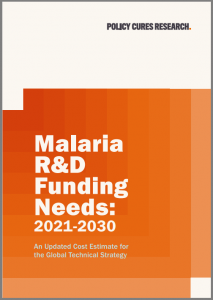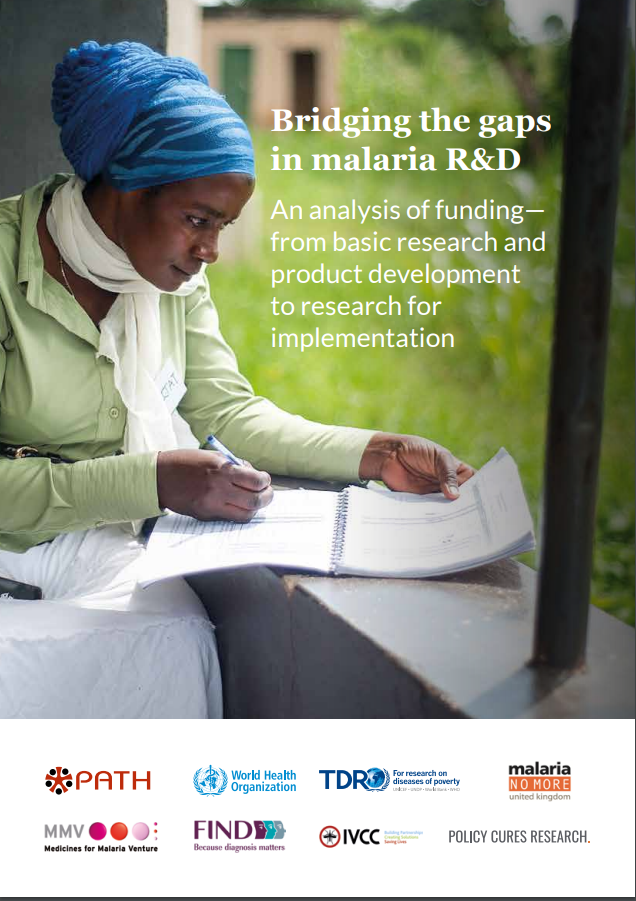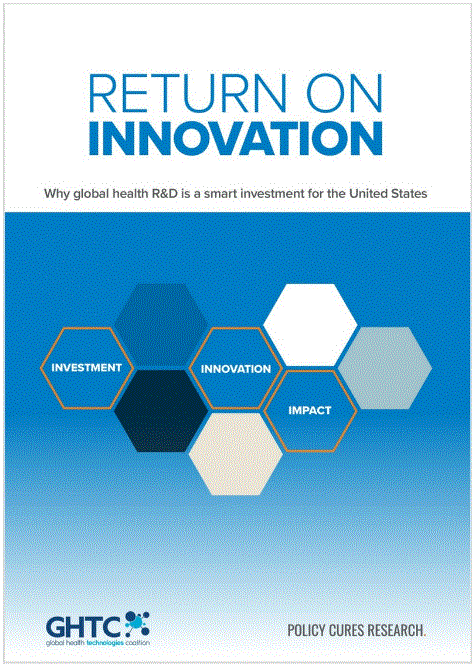ANALYSIS
We use the evidence collected through the G-FINDER project and our R&D pipeline tracker to produce a range of independent reports, which you can find below.
Together with the Global Health Technologies Coalition, we publish a report examining how US federal funding for global health R&D is delivering impact both at home and abroad.
The report details funding trends over the past 16 years for US government investment in three categories of global health R&D: neglected diseases; emerging infectious diseases, including COVID-19; and sexual and reproductive health issues. It quantifies the impact of this support in advancing new technologies to approval and a burgeoning pipeline of potential products for neglected and non-COVID emerging infectious diseases, with individual case studies on the impact of US-supported innovations. The report also examines the broader returns from these investments, including how they drive improved research capacity and economic development in low- and middle-income countries and directly benefit the US economy by creating jobs, stimulating industry investment, and contributing multiplied impact to the economy relative to their congressional appropriations.
- The full report
- The accompanying social media toolkit
- The press release
- Steady Overall, but Room to Grow. Our latest snapshot offers insights into European R&D funding from 2018 to 2022 for sexual & reproductive health issues.
- Fighting Ebola and Marburg: Unfinished Business. Our snapshot shows how R&D funding responded to Ebola and Marburg outbreaks and analyses the resulting products and pipeline.
- Contraception R&D: Broadening Horizons to Meet a Diversity of Needs. The snapshot reveals that funding stagnated between 2018-2019 and then declined between 2020 and 2021. Despite this, we find encouraging trends towards human-centred design in contraceptive innovations.
- A Need for Novel Diagnostics: Meeting the Moment. Together with FIND, the global alliance for diagnostics, we shed light on potential key drivers in the ongoing shortfall in diagnostics R&D investment for neglected diseases, emerging infectious diseases and sexual & reproductive health issues.
- A Decade of R&D Funding for Platform Technologies. This snapshot uncovers how platform technologies have benefitted from increased levels of funding over the past 10 years and reveals why they offer promising pathways for faster product development across multiple disease areas.
- Charting the R&D Response to COVID-19. Our analysis examines COVID-19 R&D investment and funding flows in the first year of the pandemic. The report covers global funding, types of products funded, funders and funding streams.
- An Unmet Need for Soil-transmitted Helminth Drugs. This snapshot provides an overview of R&D gaps, funding trends and the pipeline for soil-transmitted helminth drugs.
- An Unmet Need for Chagas’ Disease Diagnostics. This report looks at funding for Chagas diagnostics R&D as well as the current diagnostics pipeline.
- Impact of National Economic Trends on Publicly Funded Neglected Disease R&D: full report and executive summary. This analysis uncovers several robust historical relationships between government spending, ODA and neglected disease R&D funding.
- Eliminating HPV-related Cervical Cancer: the Role of Preventive Vaccine R&D. This report analyses funding trends for HPV R&D from 2018 to 2020 and looks at the role of vaccines in driving investment into this disease area.
- Next Generation Chemical Vector Control: Essential Tools in the Battle Against Malaria. This report provides a trend analysis of chemical vector control product (VCP) R&D funding from 2007-2018, a deep dive into the new dual insecticide-treated net (Interceptor G2), and an outlook of the chemical VCP development pipeline (also see press release).

Data on global investment in neglected disease R&D is collected through the G-FINDER survey and analysed in our annual G-FINDER reports, which describe how R&D investment is allocated across diseases and product types, funding trends over time, and potential gaps in funding.
The 2023 Neglected Disease G-FINDER report, The Higher Cost of Lower Funding, covers R&D funding from the 2022 financial year. The report provides headline funding figures and trend analyses for global investment into research and development of new products to prevent, diagnose, control or cure neglected diseases in developing countries. Content includes:
- The full report and executive summary
- The accompanying social media toolkit
- The press release
- The launch event recording
All underlying data are available on our data portal for supplementary graphs and tables.
Previous Neglected Disease G-FINDER reports are here:
- 2022 G-FINDER report: The status quo won’t get us there and its 8-page executive summary
- 2021 G-FINDER report: New perspectives and its 6-page executive summary
- 2020 G-FINDER report: Where to now?
- 2019 G-FINDER report: Uneven progress and its 6-page executive summary
- 2018 G-FINDER report: Reaching new heights
- 2017 G-FINDER report: Reflecting on a decade of global investment
- 2016 G-FINDER report: A pivotal moment for global health
The 2016 G-FINDER report was developed in collaboration by Policy Cures Research and Policy Cures. It can also be downloaded on their website here.
The G-FINDER neglected disease series was created by Policy Cures. The first eight reports in the series – G-FINDER 2008-2015 – were published by Policy Cures and can be downloaded on their website here.
The new sexual and reproductive health G-FINDER report, Beyond Spillovers, provides a comprehensive look at the R&D landscape for SRH products and technologies that are applicable to low- and middle-income country settings. It shows the latest R&D funding trends for sexually transmitted infections, HPV and related cervical cancer, contraception, multipurpose prevention technologies, preeclampsia & eclampsia, and postpartum haemorrhage as well as multi-issue R&D.
- Read the 2023 SRH G-FINDER report: Beyond Spillovers and its executive summary
- Watch the launch briefing which presented these slides
- Explore the data from the SRH report on our data portal
- Share the report findings with this digital toolkit
The previous SRH G-FINDER report, covering investments in 2018, is available here.
The Accelerating Innovation for Mothers (AIM) project – spearheaded by the Concept Foundation and delivered in partnership with Policy Cures Research and Burnet Institute – was created with the aim of fostering greater investment in and development of critical maternal health medicines for seven significant pregnancy-related conditions, where biomedical product gaps exist:
- Preterm labour/birth
- Preeclampsia/eclampsia
- Intrauterine growth restriction
- Postpartum haemorrhage
- Intrapartum foetal distress
- Maternal enteric microbiome/environmental enteric dysfunction
- Maternal iron deficiency anaemia
As part of this work, Policy Cures Research has created a comprehensive database profiling medicines, diagnostics, and devices – both approved and in the development pipeline – for these seven conditions. The database is accessible here.
Findings from the pipeline are detailed in the following reports:
- Landscape of Medicines Development for Five Pregnancy-Related Conditions 2000-2021
- Snapshot: R&D landscape of postpartum haemorrhage devices (2000 and 2023) (May 2023)
We have also published several articles with insights provided by the database:
- Analysis of a maternal health medicines pipeline database 2000–2021: New candidates for the prevention and treatment of fetal growth restriction in BJOG (February 2023)
- Systematic evaluation of the pre-eclampsia drugs, dietary supplements and biologicals pipeline using target product profiles in BMC Medicine (November 2022)
- Target product profiles for novel medicines to prevent and treat preeclampsia: an expert consensus in PLOS Global Public Health (November 2022)
- Expert consensus on novel medicines to prevent preterm birth and manage preterm labour: target product profiles in BJOG (October 2022)
- Innovations in the prevention and treatment of postpartum hemorrhage: analysis of a novel medicines development pipeline database in the International Journal of Gynecology & Obstetrics (June 2022)
Policy Cures Research and Wellcome have partnered to create a comprehensive database of all snakebite envenoming medicines with direct action on snake venom toxins that have either been investigated or been available for clinical use since in 2015.
We found a total of 127 antivenom products marketed or available for use, along with 196 candidate medicines (drugs and biologics) actively investigated within the last seven years since previous major reviews. This platform provides a much-needed tool to evaluate and prioritise candidates and products under development or in use, with a view to accelerating progress in snakebite therapeutics R&D.
- Explore the online database portal here
- Download the full database in Excel or view available products for snakebite envenoming here and investigational candidates here
- Read our accompanying report here
Our research validates that currently available snakebite products are many, but uniform: they are entirely animal plasma-derived antibody-based antivenoms; highly species specific and immunoreactive; and require only limited safety and effectiveness to enter the market.
Encouragingly, novel SBE therapeutics under investigation are many and diverse, and include an array of both biological and small molecule product types: new plasma-derived antivenoms; recombinant (some humanised) antibody products; whole proteins or peptides; DNA aptamers; synthetic small molecules; and botanical extract isolates and compounds. While most are in early stages of research, repurposed drugs account for over a third of all candidates, possibly indicating a faster pace of development to come.
Our 2019 report Global funding for snakebite envenoming research 2007-2018 explores the results of the first ever survey on global investment in snakebite research. More information is available below.
Our latest G-FINDER report is a comprehensive analysis of R&D investments to fight emerging infectious diseases in 2019 and 2020. For the first time, we provide an in-depth look at R&D funding for COVID-19, in addition to priority diseases such as Ebola, Zika and Disease X.
Resources include:
- The full report: Landscape of Emerging Infectious Disease R&D: From Pandemic Response to Pandemic Resilience
- This social media toolkit with key messages from the report and visuals summarizing funding trends
- Our accompanying press release
- Our data portal, where you can create your own visualisations using data from all our health areas (emerging infectious diseases, neglected diseases, and sexual and reproductive health)
- Senior Analyst Dr. Paul Barnsley joined the Contain This podcast to discuss the report’s findings and implications for global health security
The previous report, covering investments from 2014 to 2018, is available here.
We contributed to the WHO’s 2021 World Malaria Report, an in-depth update on global and regional malaria data and trends. Using the latest G-FINDER data, we analysed funding flows, including by product type and by sector. Our work can be found page 64 onwards.

In 2015, the World Health Organization (WHO) published the Global Technical Strategy for Malaria: 2016-2030 (GTS), setting out a pathway to achieving the goal of reducing the global malaria burden by 90% by 2030, and estimating the investment that would be needed to make this happen. The R&D component of these cost estimates was based on work done by Policy Cures.
Our 2021 report provides a refreshed estimate of the R&D funding needs for the remaining years of the GTS period. It takes into account changes in the malaria R&D landscape in the years following the original modelling exercise, including new or evolving research priorities, improved assumptions and progression of the existing R&D pipeline.
Policy Cures Research publishes country-specific funding profiles based on the data gathered as part of the G-FINDER survey.
G-FINDER 2019 key findings: EU funding of poverty-related and neglected disease R&D. This fact sheet provides a brief summary of the 2018 funding for neglected disease R&D provided by the European Commission, through Horizon 2020 and the European and Developing Countries Clinical Trials Partnership (EDCTP). It breaks down changes in the balance of European Union funding between EDCTP and Horizon 2020 programmes and provides a summary of the allocation of EU funding across individual diseases and stages of R&D.
The findings from Policy Cures Research’s report Global funding for snakebite envenoming research 2007-2018, commissioned by the Wellcome Trust, were presented at the third Snakebites Funders Forum, hosted by the Wellcome Trust in London on 15 November 2019.
The findings explore the results of the first ever survey on global investment of snakebite research, which was conducted as part of this project. The project was based on the G-FINDER survey of neglected disease biomedical R&D, which was expanded to include snakebite-related operational, implementation and health systems and policy research, based on the areas of interest identified by the Wellcome Trust and a panel of independent international experts.
The survey collected 12 years of data (2007 to 2018), allowing for time-series analysis. This report provides an overview of the landscape of researchers active in snakebite envenoming research and explores trends across the 12-year period, highlighting areas of unmet need.
Snakebite envenoming was also included in the G-FINDER survey for neglected diseases for the first time in 2019. Investment in biomedical R&D for snakebite envenoming will continue to be tracked by G-FINDER in future years.
Policy Cures Research, together with the Foundation for Innovative New Diagnostics, the Innovative Vector Control Consortium, the Medicines for Malaria Venture, and the WHO’s Global Malaria Programme, contributed to this 2018 report developed by Malaria No More UK, PATH and the WHO Special Programme for Research and Training in Tropical Diseases, which looks at global funding for malaria R&D over the last decade, and highlights gaps in financial reporting and monitoring tools to document funding for malaria research for implementation. The report covers findings from a pilot study on malaria research for implementation funding, which includes implementation research, operational research, and health systems research. It highlights the importance of improving coordination across intervention areas, developing more innovative funding approaches and continuing existing tracking of funding flows.
The report expands on an interim PCR publication, released earlier in 2018, titled Investigating a Second Valley of Death in Malaria R&D: How is research for implementation funded? This earlier report focused on the critical role played by implementation research, operational research, and health systems research in both shaping the development of new health technologies so they are designed for the conditions in which they will be used, and ensuring that they are introduced in the right place, at the right time, and in the right quantities.
Policy Cures Research worked with the Global Health Technologies Coalition to publish a joint report on Return on Innovation in July 2017, examining the return on investment for the United States from its support of global health R&D.
The report explores the investments made and the role played by key US institutions such as the Agency for International Development, the National Institutes of Health, the Department of Defense and the Centers for Disease Control, the achievements made with the help of US investments, and how this investment has contributed to a pipeline of products to address global health needs. The report finds that US government investment of around $14 billion in R&D for global health has been a smart investment, delivering economic and security returns for Americans while playing an essential role as a catalyst for the development of new drugs, vaccines, diagnostics and other urgently-needed tools for fighting neglected disease.









